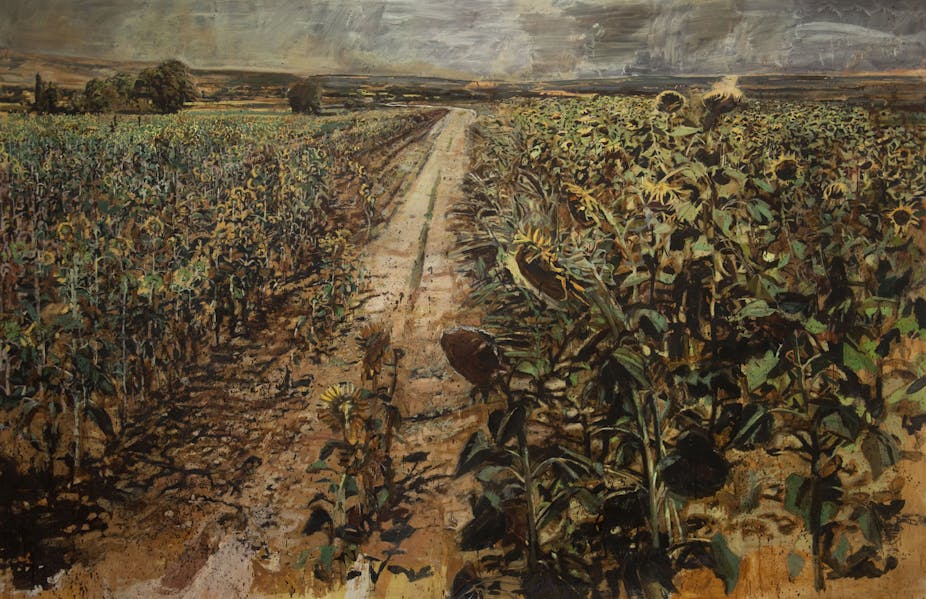Tackling Gallipoli is an onerous challenge. Embedded in the Australian psyche as a place of myth and a repository for much that we claim as quintessential to our sense of being Australian, it carries baggage that must be accommodated or unpacked with extreme care.
This is a risky business whenever it might be undertaken but at this time, when we are commemorating its centenary, it has an added degree of difficulty, with pike. Not only is it a crowded field but our sensitivities are heightened.
Western Australian artist Lev Vykopal’s two exhibitions, the second in partnership with Paul Uhlmann and both currently on show at the Fremantle Arts Centre, offer a mix of reverence, analysis, critique and poetry.
His Czech surname means “to dig” and Vykopal adopts the techniques of an archaeologist to reveal the layers of history that invest this site with its genius loci. Digging for history is not an uncomplicated process, and the artist openly acknowledges that all evidence will be morphed and transformed through interpretation.
As Jean Cocteau remarked: “History is facts which become lies in the end; legends are lies which become history in the end”. Finding a balance is at the core of this project.

Firstly, Vykopal discovered the place on a field trip in July 2013. Kalli-polis, or “beautiful city”, is a site of cultural exchange and conflict that, although picturesque, has been infected with suffering and loss for centuries.
In response to that history Vykopal mined the site for pigment and set about recording the landscape with his samples; the red from brick dust, the ochres from the soil. The precipitous cliffs rising up from the narrow beach, the deep ravines and gullies, the rusted hulks still resting on the shore and the remains of other wrecks standing sentinel to the disaster that occurred there are described with accuracy and finesse using these resources.
At Lone Pine, he recorded the remains of trenches, dappled light transforming the site of so much suffering into a bucolic landscape. Only in the dark shadows are we able to inject our memory of the horror that befell those consigned to its protection. The Nek is similarly transcribed as a Romantic landscape, a golden light glowing through the forest of pines.
If Vykopal’s project had ended here it would have failed, for though technically proficient the overlay of history is applied through the historical and cultural baggage we bring to the works rather than from anything documented in the paintings themselves.
This lack of specificity and also of humanity led him to explore the lives of those that remained on these sites and the families of the men who returned to Australia. His portraits of the descendants in Turkey and back home are wrought with the same earth pigments, and that terrain is reflected in their craggy faces. To accompany these portraits, Vykopal adopts the techniques of a historian to provide oral history interviews that link their memories to the empty landscapes we see on the walls.
At Suvla, in Turkey, history emerged, quite literally, from the ground and the works Vykopal produced there were some of the strongest in the exhibition. The Searching for the Sandringhams series documents the lost regiment of gardeners and workers from the King’s estate.
There were men who went missing during the battle and were only discovered in temporary graves years later. In the meantime the ground on which they had fought was transformed into a field of sunflowers, a vast memorial to their courage and their skills in cultivation. While the artist borrows heavily on his art school fascination with the works of Anselm Kiefer in this series, they have an intensity that fuses the landscape with the histories of those that have been before.
The land and the sky above were the reality and the hope for soldiers that fought on these few kilometres of ground from pre-history to the recent battles of the first world war.

In partnership with Paul Ulhmann, Vykopal documents that space through a series of three-dimensional reconstructions built from multiple photographs and also from paintings that depict the night sky as it appeared on the evenings of the great battles of the campaign; April 25 1925, May 8 1915 and December 20 1915.
The specificity of these works – Vykopal’s exact map coordinates and Uhlmann’s precise times and dates – reinforces the historical fact but their rendering as dislocated bronze casts and evocative paintings of luminous star systems adds a palpable poetic dimension to their enterprise.
It is the combination of all the elements encapsulated in these two exhibitions that account for the success of Vykopal’s investigation of Gallipoli as site and myth. He conjures up its spirit of place, invests that space with personal narrative and cultural memory, and with Paul Uhlmann offers us a glimmer of hope by revealing the beauty inscribed in its name, “Gallipoli”.
Gallipoli: The Beautiful City – Lev Vykopal is on display at the Fremantle Arts Centre until May 24. Details here.
Gallipoli: Earth and Sky – Lev Vykopal and Paul Uhlmann is on display at the Fremantle Arts Centre until May 24. Details here.

